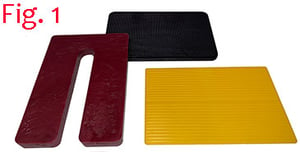The Steel Supply Company provides shims to a variety of construction trades. Solid or Slotted, Plastic or Steel. It should be noted that by solid we mean non-slotted, or what is sometimes called "Plate Shim." The plastic version of these plate shims is still solid throughout. This is differentiated from some plastic shims on the market that are actually hollow in the core. Shims that are not solid cannot deliver the compressive strength required for most construction projects. The plastic shims shown in Fig. 1 are all solid throughout. Note the slotted plastic shim on the left of the image. It's actual dimensions are 4" x 6" x 1/2" thick, solid throughout, and is compression rated to support 90,000 lbs. before permanent deflection occurs. Based on its surface area, that is approximately 4,500 psi.

To view the compression test results, click here.
Nonetheless engineers and designers often specify steel shims without considering the plastic alternative. When comparing compressive strength most plastic does not approach the 36,000 psi carbon steel offers, but the question should be asked; How much compressive strength is required? We had a project recently regarding a Relieving Angle connecting to Wedge Inserts with Askew Head Bolts. The plastic shim offered approximately double the resistance of the concrete it was being attached to and still was overlooked in favor of steel shims.
Construction grade plastic shims do offer some advantages when compared with steel. Common plastic types include High Impact Polystyrene, HIPS, High Density Polyethylene, HDPE or Korolath. Each has its own benefits but all will deliver construction grade compression strength. The initial benefit is cost. Plastic shims will almost always be significantly less expensive that steel and multiplied by the quantity used on a project the savings can be significant.
Beyond that there are some additional benefits to consider. Steel does rust and the rusted areas expand to approximately 7 times their original thickness. This can create other problems especially in locations where alignment is critical such as Curtain Wall installations. Steel also conducts electricity which can create galvanic reactions between dis-similar metals.
Plastic does not rust and does not conduct electrical current so both these conditions are eliminated. Unlike steel, plastic does react to UV rays. For this reason, it is usually confined to areas that will not receive direct sunlight.




